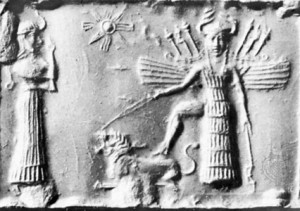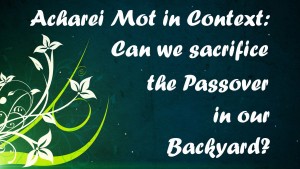Two Great New Books From Dinah Dye and Joseph Good
I want to recommend two books that I have recently read, written by two friends of mine who are absolute experts on the Temple in Jerusalem from two entirely different angles.
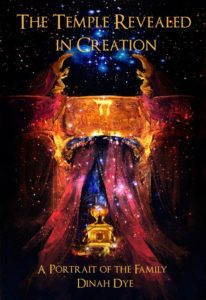 Dr Dinah Dye’s book The Temple Revealed in Creation: A Portrait of the Family is a truly marvelous first look into how the entire Scripture is organized as a Temple text from front to back. Dinah takes the reader on a tour de force journey through not only the story of the Creation Covenant, but also into the realm of Jewish midrash through beautiful fictional stories guaranteed to elevate your appreciation of what Yeshua (Jesus) lovingly called, “My Father’s House.” Dinah deftly weaves Scripture, Second Temple literature, Legendary material, and hard archaeology into the first of a series of volumes designed to awaken a love of God’s Temple within the readers – tying it all together to teach God’s intention for the structure of the family – our primary, most basic human institution which is currently under violent and relentless attack. I had the privilege of reading this before it went to print and I can assure you that it will be a life-altering experience – even if your only goal is to start understanding the language of Revelation.
Dr Dinah Dye’s book The Temple Revealed in Creation: A Portrait of the Family is a truly marvelous first look into how the entire Scripture is organized as a Temple text from front to back. Dinah takes the reader on a tour de force journey through not only the story of the Creation Covenant, but also into the realm of Jewish midrash through beautiful fictional stories guaranteed to elevate your appreciation of what Yeshua (Jesus) lovingly called, “My Father’s House.” Dinah deftly weaves Scripture, Second Temple literature, Legendary material, and hard archaeology into the first of a series of volumes designed to awaken a love of God’s Temple within the readers – tying it all together to teach God’s intention for the structure of the family – our primary, most basic human institution which is currently under violent and relentless attack. I had the privilege of reading this before it went to print and I can assure you that it will be a life-altering experience – even if your only goal is to start understanding the language of Revelation.
The second book that I want to bring to your attention is Joseph Good’s Measure the Pattern Volume I. Joseph is one of the world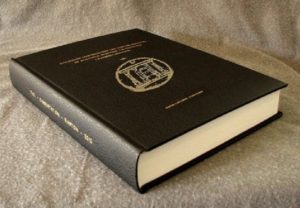 ‘s foremost experts on the Temple in Jerusalem. He has spent decades relentlessly pouring through Scripture, the Dead Sea Scrolls, Palestinian Exploration Fund archival materials, modern archaeological records, Second Temple period sources, and Talmudic writings. Joseph has led many tour groups through Israel and has even been honored to have the ear of the Temple Institute to present his findings (that is no small accomplishment). This book is the result of many years of hard core research into the Azarah and the immediate surrounding buildings of the Temple Mount. This volume is a real eye opener that will help you enter into the central focal point in the lives of Yeshua (Jesus) and His disciples. This book, along with Joseph’s Jerusalem Temple Study course, have completely revolutionized the way I teach the Scriptures to my children, and someday, other children as well.
‘s foremost experts on the Temple in Jerusalem. He has spent decades relentlessly pouring through Scripture, the Dead Sea Scrolls, Palestinian Exploration Fund archival materials, modern archaeological records, Second Temple period sources, and Talmudic writings. Joseph has led many tour groups through Israel and has even been honored to have the ear of the Temple Institute to present his findings (that is no small accomplishment). This book is the result of many years of hard core research into the Azarah and the immediate surrounding buildings of the Temple Mount. This volume is a real eye opener that will help you enter into the central focal point in the lives of Yeshua (Jesus) and His disciples. This book, along with Joseph’s Jerusalem Temple Study course, have completely revolutionized the way I teach the Scriptures to my children, and someday, other children as well.
The Temple was the center of Jewish life and plays a big part in many of Messiah’s miracles and in His ministry in general. Many people are teaching things that are not backed up by archaeology or the writings of those who were alive when the Temple stood. It is imperative that we get this right.
If you aren’t familiar with my books, I am going to go ahead and plug myself as well. I am nearing completion of Context for 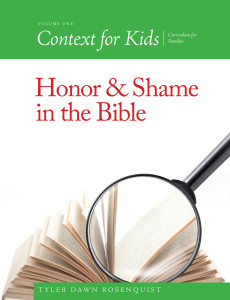 Kids Volume 2: The Ten Commandments and the Covenants of Promise so if you haven’t taken your kids through Volume 1: Honor and Shame in the Bible, this is a great time to start. Each course is 10 weeks, or 50 lessons, long and takes the entire family into an area of study generally reserved for College students – but when College students learn it, it comes burdened down with professorial assurances that the Bible wasn’t written when it says it was written or by who it says it was written by. I want to arm kids with this information presented from the vantage point of the Bible being authentic to the time periods is claims to be written in (ie. Moses really did write the first five books of the Bible and not someone during the Babylonian exile) before someone else gets to them and undermines their faith. The first book covered honor/shame culture, which reads into every Biblical story but is a big unknown to western audiences. After completion of this ten week sociology course, your family will understand not only why Yeshua (Jesus) and the Pharisees were always arguing, why Saul tried to kill David, and why Joseph’s brothers tried to kill him, but also why Islamic terrorists take so much pride in the killing of the weakest members of society when we consider their actions so cowardly.
Kids Volume 2: The Ten Commandments and the Covenants of Promise so if you haven’t taken your kids through Volume 1: Honor and Shame in the Bible, this is a great time to start. Each course is 10 weeks, or 50 lessons, long and takes the entire family into an area of study generally reserved for College students – but when College students learn it, it comes burdened down with professorial assurances that the Bible wasn’t written when it says it was written or by who it says it was written by. I want to arm kids with this information presented from the vantage point of the Bible being authentic to the time periods is claims to be written in (ie. Moses really did write the first five books of the Bible and not someone during the Babylonian exile) before someone else gets to them and undermines their faith. The first book covered honor/shame culture, which reads into every Biblical story but is a big unknown to western audiences. After completion of this ten week sociology course, your family will understand not only why Yeshua (Jesus) and the Pharisees were always arguing, why Saul tried to kill David, and why Joseph’s brothers tried to kill him, but also why Islamic terrorists take so much pride in the killing of the weakest members of society when we consider their actions so cowardly.
The Bridge: Crossing Over into the Fullness of Covenant Life is my bridge building book between those believers who do and do not believe that Torah Law is for today. Starting at mainstream Christianity, I establish Jesus as the absolutely faithful witness, t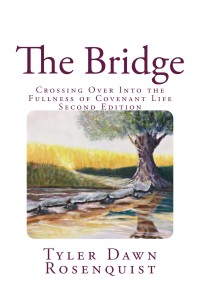 he only begotten Son of God and make the case for the Father being absolutely loving and perfect. Then I move on to Jesus’ endorsement of Moses in the Gospels. After that we re-examine Paul without undermining his ministry or his teachings, but merely putting them into context. The Bridge presents the Kingdom of God as a family with a perfect Father and perfect house rules. When many of us came to Torah we did it with a lot of zeal and no wisdom and burned bridges that we didn’t have the right to burn, and frankly weren’t even in need of burning. Too many of us broke faith with our families and now regret it and see our error, but it is now too late because they won’t listen to us anymore. If you don’t know how to speak with your family about Yeshua and Torah, I ask that you allow me to try. I treat Christians with the absolute respect that they deserve, I don’t throw any salacious urban legends at them about their traditions, and I don’t teach anything that I can’t actually prove from Scripture and archaeology. Newly revamped, I removed some of the problems with the first edition and added 20,000 more words of material.
he only begotten Son of God and make the case for the Father being absolutely loving and perfect. Then I move on to Jesus’ endorsement of Moses in the Gospels. After that we re-examine Paul without undermining his ministry or his teachings, but merely putting them into context. The Bridge presents the Kingdom of God as a family with a perfect Father and perfect house rules. When many of us came to Torah we did it with a lot of zeal and no wisdom and burned bridges that we didn’t have the right to burn, and frankly weren’t even in need of burning. Too many of us broke faith with our families and now regret it and see our error, but it is now too late because they won’t listen to us anymore. If you don’t know how to speak with your family about Yeshua and Torah, I ask that you allow me to try. I treat Christians with the absolute respect that they deserve, I don’t throw any salacious urban legends at them about their traditions, and I don’t teach anything that I can’t actually prove from Scripture and archaeology. Newly revamped, I removed some of the problems with the first edition and added 20,000 more words of material.
King, Kingdom, Citizen: His Reign and Our Identity is a book that started out as simply being about Paul as an Immigration 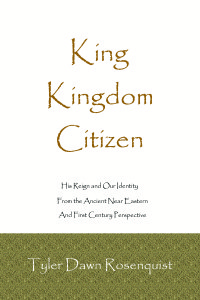 attorney working between the incoming gentile converts and the Jews (based upon a teaching from Rico Cortes) and became a beginning primer for Ancient Near Eastern studies – written in such a way that any High School student can follow along easily (unlike my review for Dinah’s book, most of my stuff is readable – sometimes I just enjoy flowery language). I establish God as a literal King, the Kingdom of Heaven as a literal Kingdom, Messiah as the heir to the Kingdoms of the Earth, and ourselves as full citizens of that Kingdom. Most of the book pertains to the first century writings, with large sections devoted to the difficult areas of Acts, Romans and a verse by verse explanation of Galatians as an Immigration text proving the right of the Galatian converts to be citizens of the Kingdom without being rabbinically circumcised as adults.
attorney working between the incoming gentile converts and the Jews (based upon a teaching from Rico Cortes) and became a beginning primer for Ancient Near Eastern studies – written in such a way that any High School student can follow along easily (unlike my review for Dinah’s book, most of my stuff is readable – sometimes I just enjoy flowery language). I establish God as a literal King, the Kingdom of Heaven as a literal Kingdom, Messiah as the heir to the Kingdoms of the Earth, and ourselves as full citizens of that Kingdom. Most of the book pertains to the first century writings, with large sections devoted to the difficult areas of Acts, Romans and a verse by verse explanation of Galatians as an Immigration text proving the right of the Galatian converts to be citizens of the Kingdom without being rabbinically circumcised as adults.
